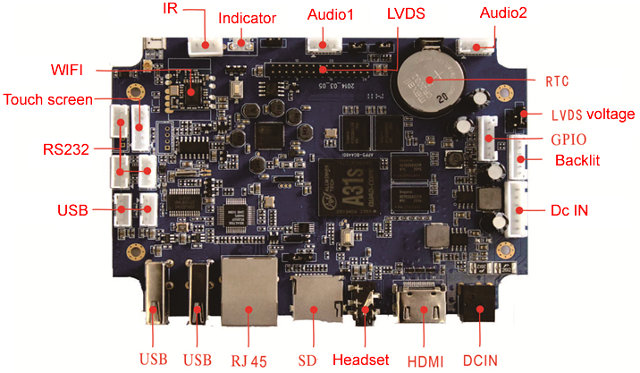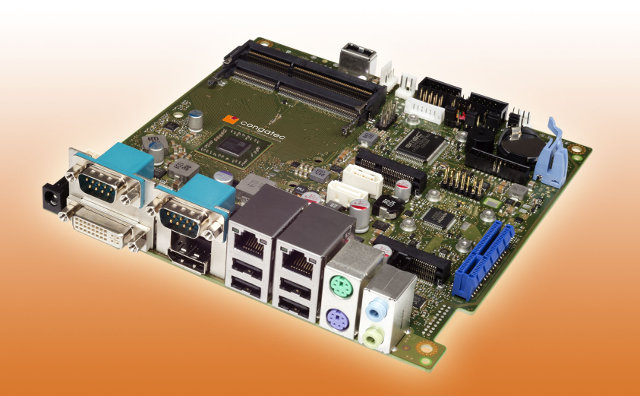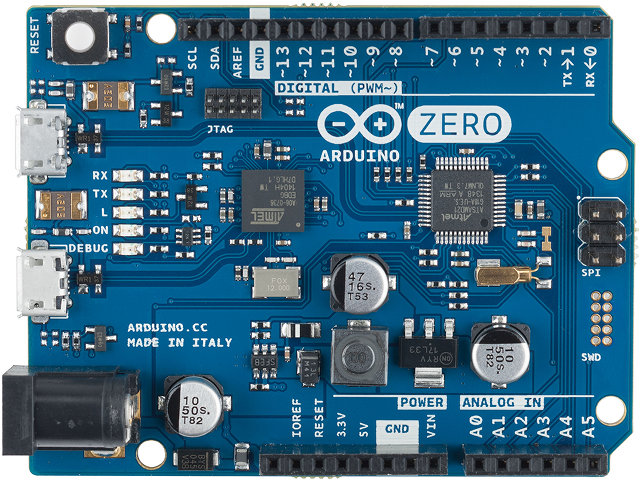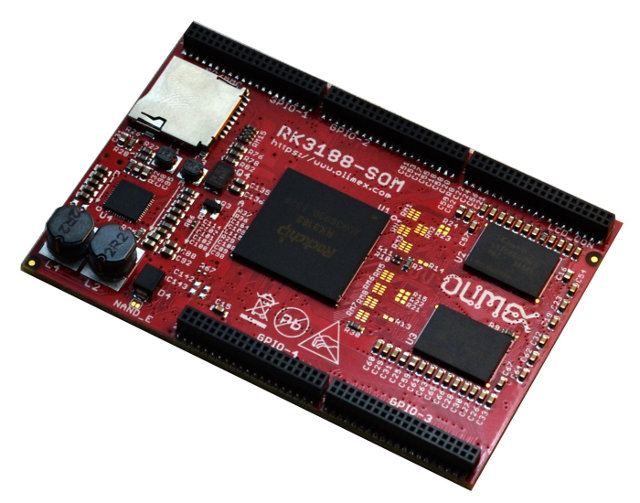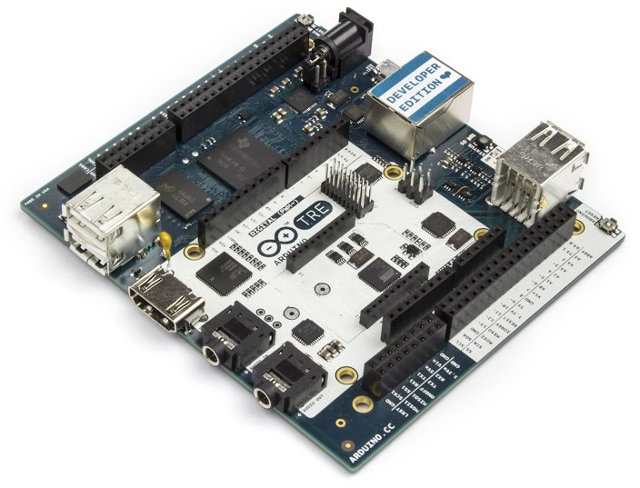Shenzhen DigiCasting, a Shenzhen based company specialized in digital signage solution, has recently introduced LX-N10 board specifically designed to connect to LVDS display for applications such as digital signage players. The board is powered by AllWinner A31s, comes with up to 2GB RAM, and optional 4GB eMMC, and various ports and headers. LX-N10 board (aka DS-108) specifications: SoC – AllWinner A31s quad core ARM Cortex A7 processor @ 1.2 GHz with PowerVR SGX544MP2 GPU System Memory – 1 GB DDR2 (2GB optional) Storage – micro SD slot up to 32GB, and optional 4GB eMMC Video Output – HDMI, LVDS + backlight + touchscreen header Audio – HDMI, 3.5mm stereo jack. Built-in 4R/20W, 8R/10W amplifier Connectivity – Wi-Fi 802.11 b/g/n, 10/100M Ethernet USB – 2x external USB 2.0 host ports, 2x internal USB headers Other Headers – GPIO (3 GPIO, 1 ADC), 3x RS-232 (2x Tx/Rx, 1x Tx/Rx/CTS/RTS), Audio 1 & 2 […]
Hello Klick is a Pressy Android Button Clone that Sells for as low as $2
Last year, Pressy launched a Kickstarter campaign for a physical button that fits into the audio jack of your Android mobile devices, and was sold for $17 in their extra successful campaign. Now you can pre-order a Pressy button for about $27, or a bit less if you order in quantities. Last month, Xiaomi showed a blatant clone of Pressy with their Mi Click that they sell for 4.9 RMB (~0.80 USD) in China. Some sellers are even re-selling the items on Aliexpress for nearly $10. It turns out there appears to be quite a few clones of the Pressy button, including Hello Klick which you can buy for $4 to $5, as even as low as $2 per piece if you order 10 Klicks. And these prices include international shipping. It’s also on Taobao starting at 4.99 RMB. It seems some models come with a stereo jack, whereas others come […]
Congatec Unveils conga-IGX Industrial mini-ITX Boards Powered by AMD G-series SoC
Congatec has recently introduced three new industrial Mini-ITX motherboards powered by dual and quad AMD Embedded G-Series SoCs, namely GX-210HA, GX-217GA, and GX-420CA, all integrated Radeon HD graphics. The company’s conga-IGX embedded motherboards are said to be particularly suited for cost-sensitive visualization and control applications. Congatec conga-IGX specifications: SoC AMD Embedded GX-210HA (2 x 1.0 GHz, L2 cache 1MB, 9 W) with AMD Radeon HD 8210E graphics @ 300 MHz AMD Embedded GX-217GA (2 x 1.65 GHz, L2 cache 1MB, 15 W) with with AMD Radeon HD 8280E graphics @ 450 MHz AMD Embedded GX-420CA (4 x 2.0 GHz, L2 cache 2MB, 25 W) with with AMD Radeon HD 8400E graphics @ 600 MHz System Memory – 2x SO DIMM Socket (1.5V / 1.35V), for up to 16GB single Channel DDR3-1333 (CL9) / DDR3-1600 (CL11) SDRAM, unbuffered, no ECC Storage – 1x mSATA (SATA-III), 2x SATA connectors Connectivity – 2x […]
Xiaomi MiPad is a 7.9″ Tablet Powered by Nvidia Tegra K1 Quad Core SoC
Xiaomi has just announced the MiPad, with a 7.9″ display using 2048×1536 (same as iPad mini) and an Nvidia Tegra K1 quad core Cortex A15 SoC with a Kepler GPU. There will be two versions one with 16GB flash, and the other with 64GB, which will be sold respectively for 1499 and 1699 CNY (~$240 and $275). Here are the specs for the MiPad: SoC – Nvidia Tegra K1 quad core Cortex A15 processor @ 2.2 GHz with a 192-core Kepler GPU System Memory – 2GB LPDDR3 Storage – 16 or 64GB eMMC, extensible to 128GB via microSD card Display – 7.9” IPS display, 2048×1536 326 PPI Camera – 8MP rear / 5MP front camera Connectivity – 802.11ac 2×2 Wi-Fi Battery – 6700 mAh battery Dimensions – 202.1 x 135.4 x 8.5 mm Weight – 360 grams The first tablet by Xiaomi happens to be the first consumer tablet featuring […]
Arduino Unveils Arduino Zero Board Featuring Atmel SAMD21 Cortex M0+ MCU
Arduino and Atmel have jointly announced the latest addition to the Arduino family with Arduino Zero, a development board based on Atmel SAMD21 ARM Cortex M0+ MCU with the same form factor and headers as Arduino UNO / Leonardo. Arduino Zero specifications: Microcontroller – Atmel ATSAMD21G18 32-bit ARM Cortex M0+ MCU @ 48 MHz with 32 KB SRAM, 256 KB flash, up to 16KB EEPROM (By emulation). 48-pin LQFP package. Digital I/O Pins – 14, with 12 PWM and UART Analog Input Pins – 6, including 5 12bits ADC channels and one 10 bits DAC DC Current per I/O Pin – 7 mA USB – 2x micro USB ports Debugging – USB via Atmel’s Embedded Debugger (EDBG) on-board debugger, and JTAG Misc – reset button, 5 LEDs (Tx, Rx, L, On, Debug) Operating Voltage – 3.3V That’s about all we know for now, as tools support (Arduino IDE?), availability and […]
How to Boot a Headless Linux Image on Amlogic S802 TV Boxes (Tronsmart Vega S89 Elite)
As some of you already know, I’ve been playing around with Tronsmart Vega S89 Elite, an Android TV Box powered by Amlogic S802 quad-core ARM Cortex A9r4 processor at 2 GHz. Today, I’ll show how to boot a headless Linux image on any Amlogic-based S802 TV Box from the network. The instructions can mainly be used as a starting point for developers, as it requires access to a serial terminal via UART, but if you’ve never done it before, the instructions should be easy enough to follow. Everything is loaded from the network, the kernel (via boot.img) is loaded via TFTP, and the rootfs (Linaro ALIP image) is mounted via NFS, so it’s nearly impossible to brick your device using the method provided. Linaro ALIP rootfs comes with LXDE, but at this stage, the desktop environment is not showing, even though my HDMI TV is properly detected by the drivers. […]
Olimex Showcases RK3188-SOM Module and RK3188-EVB Evaluation Board
After launching AllWinner and Texas Instruments SoMs earlier this month, Olimex appears to be on a roll, and the company showed some working prototypes of their upcoming Rockchip RK3188 quad core ARM Cortex A9 system-on-module, and corresponding evaluation board called RK3188-SOM-EVB including both a baseboard and a SoM. Preliminary specifications for RK3188-SOM: SoC – Rockchip RK3188 quad core ARM Cortex A9 @ 1.6Ghz with Mali-400 MP4 CPU System memory – 1GB DDR3 Storage – micro SD card slot, and optional 4GB NAND flash Power Management IC Debugging – debug UART console Misc – 2x buttons, 3x status LEDs Connectors – 5 GPIO connectors 2×20 pins 0.05″ step There will be two models: RK3188-SOM and RK3188-SOM-4GB, the latter adding 4GB NAND Flash. Both will be available in June for respectively 40 and 45 Euros per piece for 1k orders. For development and evaluation purpose, the company will also provide an open source hardware base board, RK3188-SOM-EVB, […]
Arduino TRE Powered by TI Sitara AM335x Enters Beta with 50 Developer Boards Available for Purchase
Most official Arduino boards are based on Atmel AVR MCUs that allow hobbyists to control GPIOs, or low level interfaces, which is fine for applications that do not require much processing power. In the last couple of years however, the Arduino team has gone up the processor scale, first with Arduino Due with an ARM Cortex M3, then Arduino Yun with a MIPS processor running OpenWRT, and there latest board Arduino TRE features a Texas Instruments Sitara AM3359 AM3358 processor capable of running any Linux distributions supporting ARM. The board was announced last year, and Arduino has now launched a beta program where developers can purchase one of the 50 “Arduino TRE Developer Edition” boards for 149 Euros + VAT. Arduino TRE specifications (Parts related to TI Sitara highlighted in green): SoC – Texas Instrument Sitara AM3359AZCZ100 AM3358 (See comments) ARM Cortex A8 processor @ 1 GHz with PowerVR SGX530 […]


